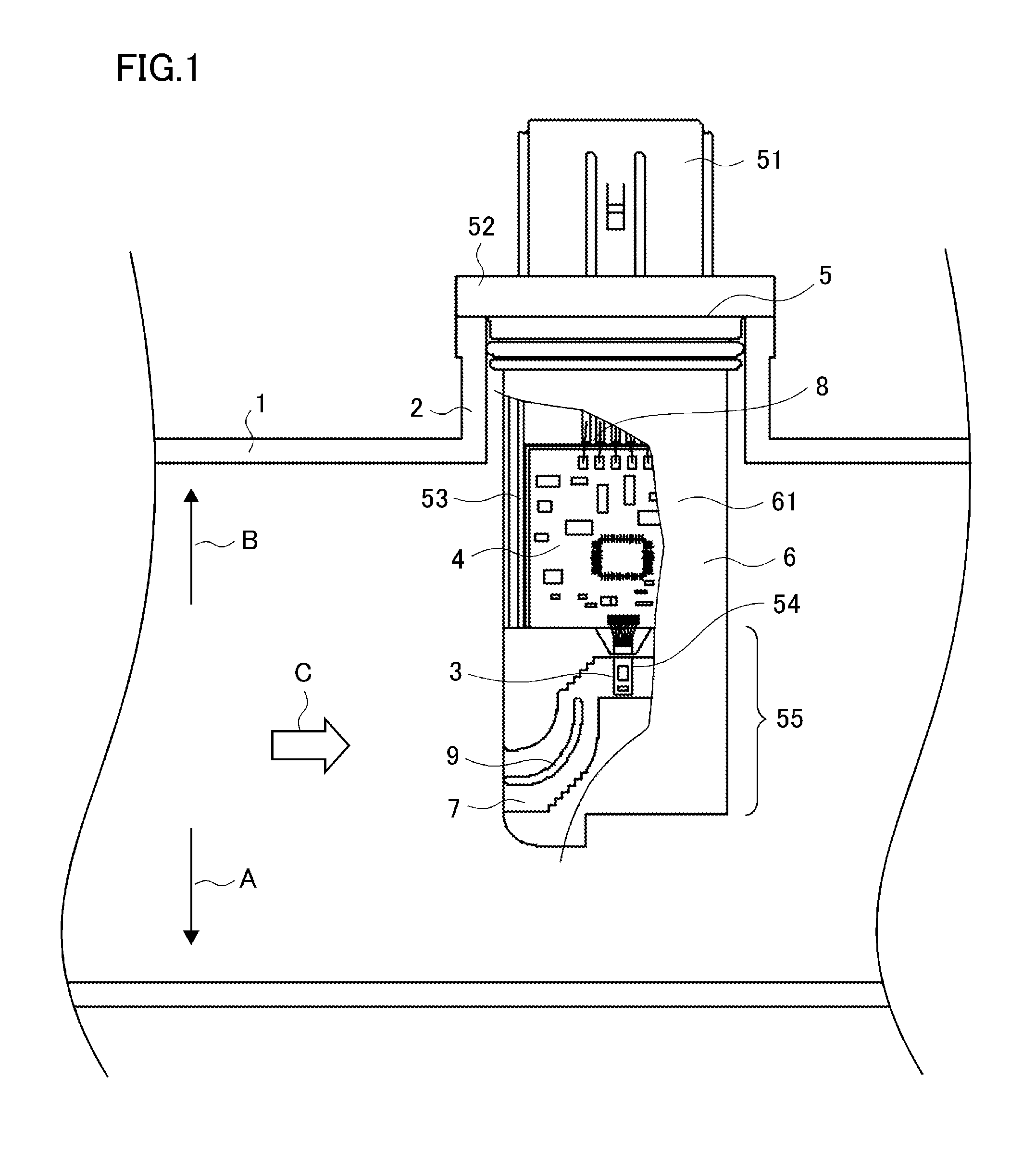Flow rate measuring apparatus
a flow rate and measuring device technology, applied in the direction of engine testing, structural/machine measurement, instruments, etc., can solve the problems of large dust with a particle diameter of 100 to 200 m, inability to remove 100 m or less of particles by purifying filters, and relatively small dust, etc., to achieve good balance between dust tolerance and flow rate detection accuracy, reduce collision energy, and high reliability
- Summary
- Abstract
- Description
- Claims
- Application Information
AI Technical Summary
Benefits of technology
Problems solved by technology
Method used
Image
Examples
first embodiment
[0053]A flow rate measuring apparatus in accordance with a first embodiment of the invention is described below with reference to the drawings. FIG. 1 is a partially cutaway front view of the flow rate measuring apparatus in accordance with the first embodiment. FIG. 2A is a front view and FIG. 2B is a side view of the flow rate measuring apparatus in accordance with the first embodiment in which a bypass passage and its surroundings are enlarged. Note that, through all the drawings referred to in the following description, the same or corresponding components are denoted by the same reference numerals.
[0054]The flow rate measuring apparatus in accordance with the first embodiment measures flow rate of fluid to be measured passing through a pipe. For example, as shown in FIG. 1, when intake air passing through an intake pipe 1 of an internal combustion engine is fluid to be measured, an insertion hole 2 that is a through hole into which the flow rate measuring apparatus is to be ins...
second embodiment
[0108]FIG. 14 is a front view of a flow rate measuring apparatus in accordance with a second embodiment of the invention in which a bypass passage and its surroundings are enlarged. In the second embodiment, the plate-like member 9 is formed to have a plate thickness t, the ratio of which to the bypass passage height H is generally less than or equal to 0.2 (i.e., t / H≦0.2). Note that the rest of the configuration is the same as that of the first embodiment, and will not be repeatedly described.
[0109]FIG. 15 shows the relation between the ratio of the plate thickness t of the plate-like member 9 to the bypass passage height H (t / H) and the air turbulence at the flow rate detecting part 33. Note that the definition of the air turbulence at the flow rate detecting part 33 is as described in the first embodiment with reference to FIG. 8A, and will not be repeatedly described.
[0110]As seen from FIG. 15, placing the plate-like member 9 initially causes the air turbulence at the flow rate ...
third embodiment
[0112]FIG. 16 is a front view of a flow rate measuring apparatus in accordance with a third embodiment of the invention in which a bypass passage and its surroundings are enlarged. In the third embodiment, in the bypass passage 7, the first passage part 72 is omitted and a first bending part 73a is placed near the inlet 71. Note that the rest of the configuration is the same as that of the first embodiment, and will not be repeatedly described.
[0113]In the third embodiment, in comparison with the first embodiment, the position of a first step-shaped part 731a provided on the first bending part 73a is closer to the inlet 71. So, as shown in FIG. 16, when dust entering the bypass passage 7 collides with the first step-shaped part 731a and rebounds, the dust is likely to be ejected to the outside of the bypass passage 7 independent of location and angle of rebounding. Accordingly, the total amount of dust entering the bypass passage 7 can be significantly reduced.
[0114]Thus, according ...
PUM
 Login to View More
Login to View More Abstract
Description
Claims
Application Information
 Login to View More
Login to View More - R&D
- Intellectual Property
- Life Sciences
- Materials
- Tech Scout
- Unparalleled Data Quality
- Higher Quality Content
- 60% Fewer Hallucinations
Browse by: Latest US Patents, China's latest patents, Technical Efficacy Thesaurus, Application Domain, Technology Topic, Popular Technical Reports.
© 2025 PatSnap. All rights reserved.Legal|Privacy policy|Modern Slavery Act Transparency Statement|Sitemap|About US| Contact US: help@patsnap.com



